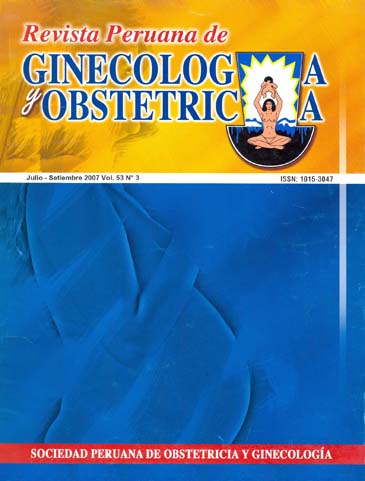Desproporción fetopélvica en un hospital de lima: prevalencia, consecuencias, predicción y prevención
DOI:
https://doi.org/10.31403/rpgo.v53i1034Resumen
OBJETIVO. Determinar las variables maternas y fetales que predicen la desproporción fetopélvica (DFP). LUGAR. Hospital Nacional Docente Madre-Niño San Bartolomé. DIISEÑO. Estudio clínico retrospectivo. PARTICIPANTES. Gestantes con detención del segundo estadio del parto y nacimiento por cesárea. INTERVENCIONES. Se revisó nuestra base de datos perinatales, del 1 de enero de 1991 al 31 de diciembre, 1999. Se definió DFP como la detención del parto durante 2 horas en nulíparas y 1 hora en multíparas, durante el segundo estadio del parto, y el nacimiento ocurrió por cesárea. Se realizó análisis de regresión logística (ARL) y ROC para predecir la DFP. PRINCIPALES MEDIDAS DE RESULTADOS. Prevalencia de DFP y condiciones asociadas. RESULTADOS. La prevalencia de DFP fue 1,28% (583/45,386). Las mujeres con DFP presentaron mayor probabilidad de talla menor de 160 cm, nuliparidad, peso pregestacional menor de 50 kg, preeclampsia, eclampsia, infección urinaria, internamiento antenatal y muerte materna (p < 0,01) y los recién nacidos con DFP presentaron mayor probabilidad de PC mayor de 34 cm, rotura prematura de membranas fetales, reanimación neonatal, Ápgar menor de 7 a minutos 1 y 5, dificultad respiratoria, asfixia perinatal, sepsis, hiperbilirrubinemia, tamaño grande para la edad de gestación y admisión en UCIN (p < 0,01). El riesgo de DFP en nuestra población puede establecerse como –1,069 + 0,012 PC en mm + 0,001 PRN en gramos -0,498 paridad -0,057 talla materna en cm -0,005 TRN en mm. El PC presenta mayor sensibilidad y especificidad en la identificación de DFP que el peso al nacer y que el índice ponderal neonatal (p < 0,001). CONCLUSIONES. La desproporción fetopélvica ocurrió en 1,28% de los embarazos revisados y comprometió seriamente la salud y la calidad de vida de la mujer y su hijo. Se encuentran en particular riesgo la mujer nulípara con talla menor de 160 cm y el feto con PC mayor de 34 cm.Descargas
Descargas
Publicado
2015-06-22
Cómo citar
Pacora, P., Ingar, W., Buzzio, Y., Reyes, M., & Oliveros, M. (2015). Desproporción fetopélvica en un hospital de lima: prevalencia, consecuencias, predicción y prevención. Revista Peruana De Ginecología Y Obstetricia, 53(3), 193–198. https://doi.org/10.31403/rpgo.v53i1034
Número
Sección
Artículos Originales
















